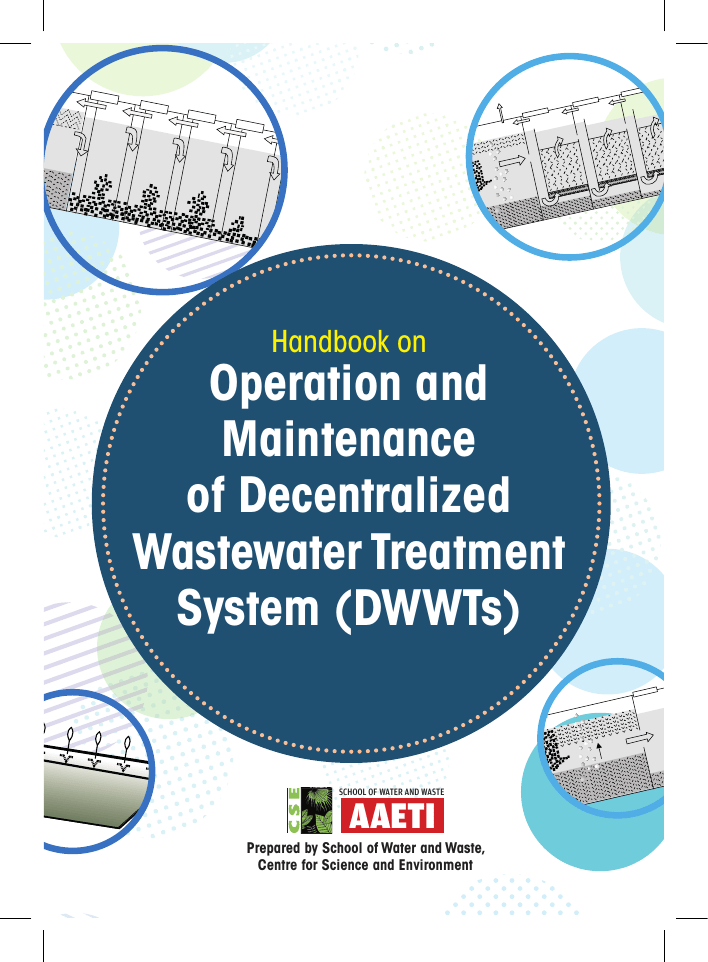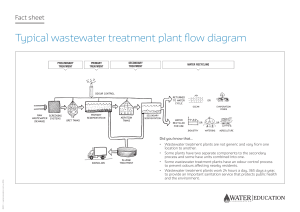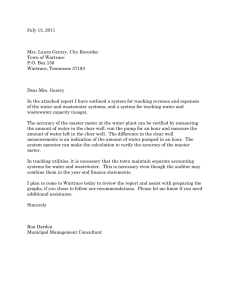Handbook-Operation&Maintenance-of-Decentralized-Wastewater-Treatment-Systems-CSE
advertisement

Handbook on Operation and Maintenance of Decentralized Wastewater Treatment System (DWWTs) SCHOOL OF WATER AND WASTE AAETI Prepared by School of Water and Waste, Centre for Science and Environment Handbook on Operation and Maintenance of Decentralized Wastewater Treatment System (DWWTs) SCHOOL OF WATER AND WASTE AAETI Prepared by School of Water and Waste, Centre for Science and Environment Bathroom Kitchen *ABR – Anaerobic Baffled Reactor *AF – Anaerobic Filter *PGF – Planted Gravel Filter *PP – Polishing Pond Toilet Reuse of Treated Wastewater Grease Trap Reference: http://www.eepco-tz.org/ dewats/dewats-illustration/ PGF* Secondary Treatment Tertiary Treatment PP* ABR + AF* Settler Primary Treatment Typical Layout of Decentralized Wastewater Treatment System (DWWTs) Sectional View of Different Modules of DWWTs Septic Tank / Settler Anaerobic Baffled Reactor (ABR) Anaerobic Filter (AF) Planted Gravel Filter (PGF) Polishing Pond Purpose of the handbook » To provide a concise and complete understanding about maintenance issues and their remedies, which arise in day to day operation and maintenance of DWWT system. » To provide an insight about the safety measures to be adopted during COVID-19 » To be used as a handy user guide as well as monitoring tool Target Group This handbook is intended to be used by the DWWTs operator, supervisor, maintenance in-charge, monitoring in-charge, caretaker of the DWWTs, gardener, implementer, resident welfare associations (RWAs) etc. Need for Operation and Maintenance Proper operation and maintenance of a DWWT system ensures smooth functioning and expected performance of the system throughout the design period. Operational Activities: Activities to fulfill objectives of the treatment and to check performance of the different modules of the DWWT system. Maintenance Activities: Activities that ensure the smooth functioning of different treatment modules based on regular inspections. » DWWT system operated and maintained efficiently has the potential to be productive and sustainable economically, environmentally and socially. Frequently Asked Questions (FAQs) Is DWWTs environmentally and economically viable? Yes, DWWTs are designed to maximize the reliance on natural processes and its O&M does not require external energy and can be done by semi skilled labour. What will happen if we completely empty the baffled reactor during desludging process? If we completely empty the baffled reactor during the desludging process then all the necessary micro-organisms required for the biological decomposition of organic matter will be removed and the reactor will require addition of fresh cow dung/ existing septic tank waste for the re-commissioning/innoculation purpose. How to control foul smell/odour in treated wastewater? Improper aeration leads to the foul smell and odour in the treated wastewater. To control this, avoid to store the treated wastewater for more than two days. Also ensure that there is no hindrance in subsurface flow of wastewater in PGF bed. Regular Operational and Maintenance Instructions » Make sure to adopt necessary precautions and wear all the required PPEs (Mask, Hand Gloves, Safety Jacket, Gum Boots etc.) while performing the regular operational and maintenance activities. » D uring maintenance, the system should not be closed completely, make sure that activities are carried out in phased manner. 1 Check for free wastewater flow When? In case of overflow or no flow of wastewater into the system Why? To identify possible leakages and obstructions in pipes, filter material of ABR and PGF bed and different treatment modules of the system Settler PGF ABR+AF Polishing Pond Leakages/obstructions to be checked in pipes from source to primary treatment unit and within inter-module pipes 2 Removal of oil and grease from Grease Trap When? Regular cleaning (twice or thrice a week) depending on the quantum of oil and grease generated also in case of overflow, backflow or foul smell Why? To avoid clogging and interruption in further biological treatment · F or small grease traps, the waste could be removed manually by scooping it into watertight plastic bags and disposed of together with other kitchen refuse. · F or large grease traps, one installed in restaurants and food processing factories should employ reputable collectors to collect the grease trap waste for proper disposal through incineration or land filling. Land filling should be done at-least 30 feet away from any water tank or bore well to avoid contamination. Scum can be collected at one place and industries can be explored were it can be reused such as soap and biodiesel. Oil can be filtered out from scum and used for burning purposes. · · Reference: https://www.thomasville-nc.gov/Home/ShowDocument?id=102 http://hrfog.com/Content/EducationalMaterial/Grease-Trap-Cleaning-Guide.pdf 3 Removal of scum layer from Settler When? Once in fortnight or in case of excess scum / foul smell Why? To avoid clogging and interruption in further biological treatment De-scumming · Removal of hard scum layer with spades · Soft scum removal by sieving · Feeding into biogas digesters to increase gas production Reference: https://www.researchgate.net/publication/283713518_Operational_measures_to_cope_with_ FOGscum_in_DEWATS_plants https://sswm.info/sites/default/files/reference_attachments/BORDA%202008%20 Decentralized%20Wastewater%20Treatment%20System%20-DEWATS%20Manjuyod%20 Public%20Market.pdf 4 Desludging of the sludge accumulated at the bottom of Settler and Anaerobic Baffled Reactor (ABR) When? Regular desludging once in 2-3 years or in case of excess solids, BOD or COD at the outlet of ABR Why? To ensure efficient treatment and avoid clogging. Longer intervals between two successive desludging will compact the sludge accumulated in the bottom and will cause difficulties during the removal process. Reference: During desludging, chambers should not be emptied completely otherwise it will require re-commissioning of the system. https://sswm.info/sites/default/files/reference_attachments/BORDA%202008%20 Decentralized%20Wastewater%20Treatment%20System%20-DEWATS%20Manjuyod%20 Public%20Market.pdf 5 Check for minimum required water level in Planted Gravel Filter (PGF) Bed When? In case of overflow, no plant growth or prevalence of mosquitoes in abundance around PGF etc Why? To avoid overflow, mosquito breeding and death of plants Min Required Water Level 6 Removal of weed and dead leaf litter from PGF When? Once a week or in case of excess weed or litter observed on the surface Why? To avoid clogging and formation of algae in filter media and to maximize efficiency. Also, it will ensure the flow of oxygen and ultraviolet rays of the sun to enter the gravel filter. Dead leaf litter to be removed manually by using an appropriate tool (garden rake, fish net and sieve). Weed should be removed by extracting the roots also. 7 Harvesting of plants in PGF When? Once a month or, in case of excess growth of plants or observe dead leaves in PGF Why? To remove dead leaves and allow proper natural reactions such as photosynthesis 8 Replacement / Re-installation of filter media in PGF When? Once in 4-5 years or in case of clogging of filter media Why? To avoid any hindrance to the flow of wastewater and to maintain the efficiency of the treatment 9 Check for algal bloom and froth formation in Polishing Pond When? In case of froth/bubbles or greenish appearance on the surface Why? To get clearer and better quality of treated wastewater for reuse Excess algae from polishing pond should be removed manually using a fish net. 10 Testing of treated wastewater When? In regular interval of 3-6 months or in case of inefficient treatment Why? To check the performance of the system and to maintain the quality of treated wastewater Sample Testing: Sample testing should be done by authorized / NABL accredited laboratory with enlisted parameters - pH, TSS, TDS, BOD, COD, Total Ammonical Nitrogen, TKN, Total Phosphates, Faecal Coliform, Total Coliform. Sampling Points: Settler Inlet; ABR Inlet; PGF Inlet; PGF Outlet; Collection Tank/ Polishing Pond Individual taking the sample should have adequate knowledge of the preparation and handling of the sample. The monitoring in charge should be aware of the necessary things like checklist, sampling tools, guidelines and method of collection and transportation of the wastewater samples. Sampling procedure can be found in attached reference link. Reference: https://www.cseindia.org/scoping-paper-development-and-validation-8338 11 Ensure regular reuse of treated wastewater from collection tank or polishing pond When? Regular reuse of treated wastewater everyday or once in two days Why? To minimize the growth of algal bloom, foul smell and also to avoid overflow/backflow of treated water in collection tank/polishing pond Recommended norms of treated wastewater quality for different reuse options by CPHEEO Toilet Flushing Fire Protection Vehicle Exterior Washing Turbidity (NTU) SS TDS pH Temp. (ÊC) Oil and Grease Minimum Residual Chlorine <2 Nil <2 Nil <2 Nil 10 Nil Nil 1 1 1 Total Kjeldal Nitrogen BOD COD Dissolved Phosphorus Nitrate Faecal Coliform/ 100 ml Helminthic eggs/ litre 10 10 10 10 AA 10 AA 10 AA 1 1 1 10 10 10 Nil Nil Nil AA AA AA Colourless Colourless Colourless Parameter Colour Odour Note: All units in mg/l unless specified; AA - as arising when other parameters are satisfied; A tolerance of plus 5% is allowable when yearly average values are considered. Noncontact Impoundments Horticulture, Golf Courses <2 nil 2100 6.5 to 8.3 Ambient nil <2 nil Nonedible Crops AA 30 10 10 nil nil 0.5 1 nil nil nil 10 10 10 10 10 10 AA 10 AA 20 30 10 AA 20 30 1 2 5 2 5 5 10 10 10 10 nil nil 230 nil 230 AA AA <1 <1 <1 Colourless Colourless AA Colourless Colourless Aseptic (Not septic and no foul odour) Edible Crops Raw Cooked <2 Nil AA 30 12 Ensure to cover all the access covers of the system When? While not performing any operational and maintenance activities Why? To ensure proper treatment and avoid any untoward incident 13 Maintain a log-book / Register When? Regularly based on frequency of operation and maintenance activities Why? To track all the operations and maintenance activities (mentioned from point 1 to 11). It will help in smooth run of the system Reference: https://drive.google.com/file/d/1o2HXB1S6BsFpJRNQT1WeV-rT7Q_qrJrd/view?usp=sharing In view of the COVID-19 (or any WASH related pandemic) following precautions need to be adopted for smooth operations of DWWTs as well as for the safety of sanitation workers Over and above the regular O&M instructions 1 Visitor’s entry to be controlled within the plant’s premises Why? To ensure physical distancing and health safety Benefit? It will help in reducing the risk of infection through any object or human contact 2 Use Personal Protective Equipments such as Mask, Gloves, Gum Boots, Goggles/ Face Shield, Full Sleeve Clothes etc during operational and maintenance activities of the system Why? To avoid exposure to wastewater Benefit? It will help preventing the transmission of infection through nose, eyes, mouth etc while handling the wastewater 3 Avoid watering the plants by sprinkler method Why? There might be chances of infection through aerosols Benefit? It will help in minimizing the risk of infection through aerosols 4 Sanitize your hands properly, before and after touching any object Why? The logbook or any other object may be touched by some infected person Benefit? It will minimize the risk of spread of virus It is recommended to use sensor based or foot pedal sanitizer dispenser to avoid the spread of COVID-19 through the contaminated bottle because by touching the sanitization bottle one can unknowingly leave the virus on the bottle and it may transmit to other person who comes in contact with it. Reference: https://www.csir.res.in/csir-products-for-covid-19 https://drdo.gov.in/sites/default/files/whats_new_document/Technical_document_Contactless_ Sanitizer_Dispenser.pdf 5 In case of cold or flue symptoms, consult a doctor and avoid visiting the DWWT site Why? Doctor will suggest you the correct measures to avoid any severe illness Benefit? It will ensure health safety and avoid the spread of infection to others at the site 6 Use bandage and wear water proof gloves in case of any cut or wound Why? To prevent the contact of cut or wound with the wastewater Benefit? It will help in reducing the risk of infection through bloodstream 7 Use lime powder as a disinfectant in case of spillage or leakage of wastewater at site Why? To prevent human contact with infected wastewater Benefit? It will help in reducing the risk of spread of the infection through spillage or leakage of wastewater 8 Maintain a minimum safe distance of at least 6 feet (as per new norms) with your colleagues at site Why? To ensure physical distancing 6 FEET Benefit? It will help in reducing the risk of spread of the virus through human contact As per new social distancing norms CDC recommends to stay at least 6 feet (about 2 arms length) from other people. Reference: https://www.cdc.gov/coronavirus/2019-ncov/prevent-getting-sick/prevention.html 9 Used equipments and reusable PPEs to be sanitized or fumigated properly before storing Why? Used equipments may get contaminated with the virus and also it may cause the spread of the disease Benefit? After sanitization these equipments/reusable PPEs can be used again without any risk of infection 10 Dispose off masks and gloves in designated bin, In case of reusable PPE, wash with warm water and sun dry Why? Throwing masks here and there may infect others Benefit? It will provide safe disposal of used masks and gloves and also will be helpful in reducing the risk of infection used mask (including three layer · Collect mask, N95 mask etc.), head cover/cap, Covid 19 waste Covid 19 waste used PPEs such as goggles, · Collect face-shield, splash proof apron, Plastic Coverall, Hazmet suit, nitrile gloves into shoe-cover, disposable linen Gown, Red bag non-plastic or semi-plastic coverall in Yellow bags It is advisable to keep the used PPEs in a designated bag for at-least 72 hours before its disposal to avoid contamination Reference: https://cpcb.nic.in/openpdffile. php?id=TGF0ZXN0RmlsZS8yOTdfMTU5MjE0NzcwMF9tZWRpYXBob3RvMzA3NDgucGRm 11 Wash used PPEs and clothes using 0.05% chlorine solution and sun dry Why? To control the infection from virus and avoid mixing of used clothes /PPEs with other clothes Benefit? It will help preventing the mixing of infected clothes and will reduce the risk of spread of the virus infection Reference: https://www.cdc.gov/healthywater/global/sanitation/workers_handlingwaste.html 12 Wash your hands frequently with soap Why? Germs/viruses from unwashed hands can be transferred to other objects and then transferred to another person's hands Benefit? Frequent hand washing will helps prevent respiratory infections As per WHOs recent guideline, proper hand-washing requires at-least 40-60 seconds instead of 20 seconds. Hand-rub to be used for at-least 20-30 seconds to kill the germs/viruses. Earlier it was suggested to wash hands at least for 20 seconds. Reference: https://www.who.int/gpsc/5may/Hand_Hygiene_Why_How_and_When_Brochure.pdf https://globalhandwashing.org/wp-content/uploads/2020/04/UNHCR-Technical-WASHGuidance-for-COVID-19-Preparedness-and-Response-UNHCR-2020.pdf 13 Do not eat and drink at the DWWTs site Why? Germs, bacteria and viruses present in wastewater may contaminate the food and it can be the reason for several diseases Benefit? It will help safeguarding health and also prevent the risk of food poisoning Reference: https://d3n8a8pro7vhmx.cloudfront.net/cupebcvotes2014/pages/1551/attachments/ original/1457451862/Wastewater_Treatment_Plant_-_CUPE_Occupational_Health_and_Safety_ Bulletin.pdf?1457451862 14 Do not smoke and spit at the DWWTs site Why? Smoking should be prohibited to prevent the incidence of fire through flammable gases produced during treatment process. Also abstrain from spit at the site as it could be a carrier for infection Benefit? It will ensure health safety of both workers and visitors. Also it will help in reducing the risk of transmission of the infection Reference: https://www.who.int/news-room/detail/11-05-2020-who-statement-tobacco-use-and-covid-19 https://d3n8a8pro7vhmx.cloudfront.net/cupebcvotes2014/pages/1551/attachments/ original/1457451862/Wastewater_Treatment_Plant_-_CUPE_Occupational_Health_and_Safety_ Bulletin.pdf?1457451862 15 Routinely consult a doctor and as per recommendations, ensure to take vitamin supplements and vaccinations of Polio, typhoid fever, hepatitis A, hepatitis B etc. Why? To protect one's health from infectious diseases and prevent invading of viruses/bacteria Benefit? It will help strengthening the immune system Reference: https://www.cdc.gov/healthywater/global/sanitation/workers_handlingwaste.html We are grateful to the Bill and Melinda Gates Foundation (BMGF) for their support to School of Water & Waste, AAETI (a unit of CSE). Centre for Science and Environment Be Alert, Be Safe! https://www.cseindia.org/page/school-waterwaste sww-aaeti@cseindia.org




